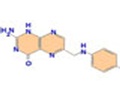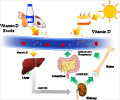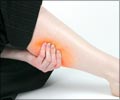Low vitamin D levels may trigger the risk of developing peripheral artery disease, according to researchers at the Albert Einstein College of Medicine of Yeshiva University.
PAD is a common disease that occurs when arteries in the legs become narrowed by fatty deposits, causing pain and numbness and impairing the ability to walk.People obtain vitamin D by making it themselves i.e. by exposing themselves to sunlight, by ingesting foods such as fish and fortified dairy products that contain vitamin D, or by taking dietary supplements.
Adequate vitamin D levels are necessary for bone health, but scientists are only beginning to explore vitamin D's connection to cardiovascular disease.
"We know that in mice, vitamin D regulates one of the hormone systems that affects blood pressure," said Dr. Michal Melamed, lead author of the study and assistant professor in the departments of Medicine and Epidemiology and Population Health at Einstein.
"Since cells in the blood vessels have receptors for vitamin D, it may directly affect the vessels, although this has not been fully worked out," Melamed added.
In order to see whether or not vitamin D might influence PAD, Dr. Melamed and colleagues analyzed data from a national survey measuring vitamin D levels in the blood of 4,839 U.S. adults.
Advertisement
The researchers found that higher levels of vitamin D were associated with a lower prevalence of PAD. Among individuals with the highest vitamin D levels -more than 29.2 nanogram per milliliter (ng/mL) - only 3.7 percent had PAD. Among those with the lowest vitamin D levels - less than 17.8 ng/mL - 8.1 percent had PAD.
Advertisement
For each 10 ng/mL drop in vitamin D level, the risk for PAD increased by 29 percent.
While these findings suggest a role for vitamin D in preventing PAD, Dr. Melamed cautions that they don't necessarily show that vitamin D truly deserves the credit.
It's possible, she says, that vitamin D levels are a marker for other health practices such as eating a healthy diet. She notes that proving a cause-and-effect relationship between vitamin D and protection against PAD will require a large randomized clinical trial in which some people receive vitamin D supplementation while others do not.
The study is published have been presented at the American Heart Association's Arteriosclerosis, Thrombosis and Vascular Biology Annual Conference 2008.
Source-ANI
RAS/L











